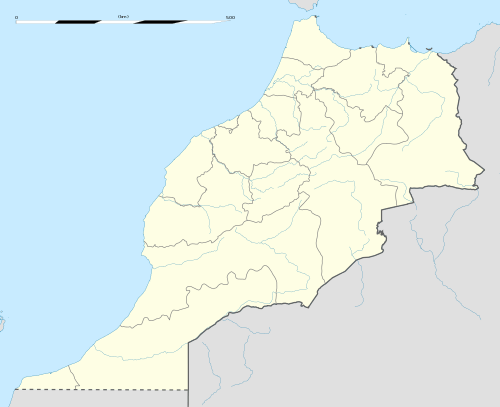Al Hoceima
| Al Hoceima/ الحسيمة Villa Sanjurjo / Taghzut ⵜⴰⵖⵣⵓⵜ | ||
|---|---|---|
 | ||
| ||
| Nickname(s): Villa, Pearl Of The Mediterranean. | ||
 Al Hoceima/ الحسيمة | ||
| Coordinates: 35°15′N 3°56′W / 35.250°N 3.933°W | ||
| Country |
| |
| Region | Tanger-Tetouan-Al Hoceima | |
| Province | Al Hoceïma Province | |
| First settled | 1925 | |
| Government | ||
| • Type | monarchy | |
| • ruler | Mohammed VI | |
| • mayor | Mohammed Boudra | |
| Population | ||
| • City | 118.463 | |
| • Metro | 395,644 [1] | |
| 2004 census [1] | ||
| Website | http://www.alhoceima.info/ | |
Al Hoceima (Riffian language: Taghzut or Biya, Arabic: الحسيمة) is a city in the north of Morocco, on the northern edge of the Rif Mountains and on the Mediterranean coast. It is the capital of Al Hoceima Province. It is situated in the territory of the Ayt Weryaghel and Ibeqquyen tribes of the Rif, who speak Tarifit Berber, locally called Tamazight.
Name
The name Al Hoceima is paradoxically an Arabic word introduced by the Spaniards since it comes from a Spanish word (Alhucemas - literally meaning "Lavenders") which is itself of Andalusi Arabic origin (Al Khazama). After independece, the Moroccan government established an Arabized name for Alhucemas coming up with Al Hoceima, following standard French spelling.
History
The Spanish started to develop Al Hoceima around 1925. General Sanjurjo landed with his troops on the beach of Al Hoceima during the Rif Rebellion and claimed the territory for Spain. He named the territory Villa Sanjurjo, after himself. Many locals still refer to the city as "Villa".
The Spanish troops built houses, schools and hospitals above the beach, creating the beginnings of the town. In the 1920s and 1930s, the town had almost no growth in population. Its name changed from Villa Sanjurjo to Villa Alhucemas, and the few streets above the beach were still occupied by mainly Spanish soldiers and their families. The first mayor was Florian Gómez Aroca.
After Morocco gained its independence in 1956, Al Hoceima developed quickly, and the Moroccan government changed its name from the Spanish Villa Alhucemas to Al Hoceima, a surprising Arabization of a Spanish word of Arabic origin. (Alhucema originally comes from the Arabic word Huzama).
The years from 1956 to 1959 were dark years for the Riffians, mainly for the people in Al Hoceima and Nador. Morocco's Hassan II became the military-commander and under his ruling a big amount of people were killed in the Rif in the years 1956 to 1959.
In the early 1950s and 1960s, when many of the city's inhabitants were poor, the small houses were all painted white and blue. These colors, representing the sea and sky, were considered the city's official colors. Later, when there was financial growth, people began painting their houses in other colors.
The town and surrounding villages were hit by two moderate earthquakes within ten years. The first, at a severity of Mw 6.0, occurred on May 26, 1994. The second, at Mw 6.4, occurred on February 24, 2004, killing more than 560 people (see 2004 Morocco earthquake).
In 2007, Al Hoceima's mayor stated that all new houses would be painted white and blue in an effort to restore the city's traditional appearance.
Al Hoceima is now a moderate-size city with an estimated population of 100,000 . It has the second-largest port of the Rif Region (Nador being the largest). The first schools built by the Spanish colonials, (a college and an elementary school) and a Spanish catholic church, still exist today.
Playa Quemado, where General Sanjurjo and his troops landed in 1925, is Al Hoceima's most popular beach. It is located just below the luxurious Mohammed V hotel, which includes a tennis court, restaurant, cocktail bar and nightclub.
On October 28, 2016, a fish-seller was crushed to death in a refuse truck, which led to large anti-government protests in November 2016.[2]
Economy
The city's income is based on fishing. Many of its former inhabitants migrated to Europe during the 1960s through 1980s; large numbers of Moroccans in the Netherlands, France and Belgium were Al Hoceima natives. Many return to Al Hoceima during the summer, stimulating its economy and encouraging investment.
Since the 1990s, many western-oriented businesses have opened in Al Hoceima, including pizza parlors, fast food restaurants and clothing stores.
Transport
The city is served by the Cherif Al Idrissi Airport.
Education
There is a Spanish international school, Instituto Español Melchor de Jovellanos.
See also
Twin towns - sister cities
 Nice, France
Nice, France Tuzla, Bosnia and Herzegovina
Tuzla, Bosnia and Herzegovina Almería, Spain
Almería, Spain Almuñécar, Spain
Almuñécar, Spain The Hague, Netherlands
The Hague, Netherlands.svg.png) Schaerbeek, Belgium
Schaerbeek, Belgium
External links
- Nador Rif News; www.ariffino.net
- Al Hoceima Photos (La page Facebook)
- Al Hoceima Photos (English)
- City Of Alhoceima Website (English)
- Galerie Al Hoceima (FR)
- (French) Alhoceima, la perle de la Méditerranée'
- (Spanish) Www.Alhucemas.info Portail Touristique Et Commerciale De La Ville D'AlHucemas'
- (French) Www. Alhoceima.info Portal de información de la ciudad de Alhoceima'
- Entry in Lexicorient (not appropriate as an external link)
- Pictures about Al-Hoceima (Thmazight)
References
- 1 2 MobileReference. Travel Morocco: Guide, Maps, and Phrasebook. Retrieved 29 March 2014.
The Al Hoceima city region has a population of 395.644 (2004 census).
- ↑ "Morocco arrests 11 over fish-seller's death in Al-Hoceima". BBC. November 1, 2016. Retrieved November 3, 2016.
Coordinates: 35°15′N 3°56′W / 35.250°N 3.933°W
| Wikimedia Commons has media related to Al Hoceima. |

